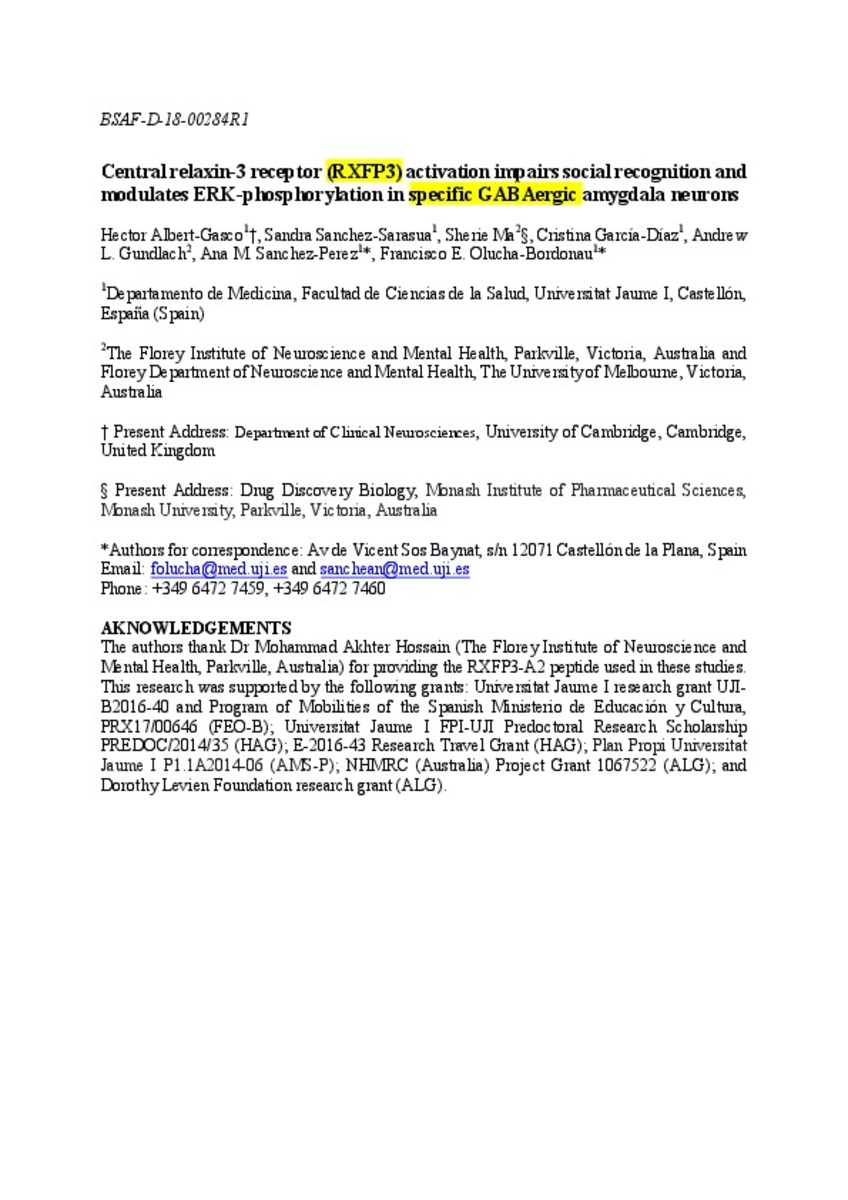Mostrar el registro sencillo del ítem
Central relaxin-3 receptor (RXFP3) activation impairs social recognition and modulates ERK-phosphorylation in specific GABAergic amygdala neurons
| dc.contributor.author | Albert Gasco, Hector | |
| dc.contributor.author | Sánchez-Sarasúa, Sandra | |
| dc.contributor.author | Ma, Sherie | |
| dc.contributor.author | García Díaz, Cristina | |
| dc.contributor.author | Gundlach, Andrew Lawrence | |
| dc.contributor.author | Sánchez-Pérez, Ana María | |
| dc.contributor.author | Olucha-Bordonau, Francisco E | |
| dc.date.accessioned | 2019-04-30T07:11:43Z | |
| dc.date.available | 2019-04-30T07:11:43Z | |
| dc.date.issued | 2019-01 | |
| dc.identifier.citation | ALBERT-GASCÓ, Héctor, et al. Central relaxin-3 receptor (RXFP3) activation impairs social recognition and modulates ERK-phosphorylation in specific GABAergic amygdala neurons. Brain Structure and Function, 2019, vol. 224, no 1, p. 453-469 | ca_CA |
| dc.identifier.issn | 1863-2653 | |
| dc.identifier.issn | 1863-2661 | |
| dc.identifier.uri | http://hdl.handle.net/10234/182382 | |
| dc.description | This is a pre-print of an article published in Brain Structure and Function. The final authenticated version is available online at: https://doi.org/10.1007/s00429-018-1763-5 | |
| dc.description.abstract | In mammals, the extended amygdala is a neural hub for social and emotional information processing. In the rat, the extended amygdala receives inhibitory GABAergic projections from the nucleus incertus (NI) in the pontine tegmentum. NI neurons produce the neuropeptide relaxin-3, which acts via the Gi/o-protein-coupled receptor, RXFP3. A putative role for RXFP3 signalling in regulating social interaction was investigated by assessing the effect of intracerebroventricular infusion of the RXFP3 agonist, RXFP3-A2, on performance in the 3-chamber social interaction paradigm. Central RXFP3-A2, but not vehicle, infusion, disrupted the capacity to discriminate between a familiar and novel conspecific subject, but did not alter differentiation between a conspecific and an inanimate object. Subsequent studies revealed that agonist-infused rats displayed increased phosphoERK(pERK)-immunoreactivity in specific amygdaloid nuclei at 20 min post-infusion, with levels similar to control again after 90 min. In parallel, we used immunoblotting to profile ERK phosphorylation dynamics in whole amygdala after RXFP3-A2 treatment; and multiplex histochemical labelling techniques to reveal that after RXFP3-A2 infusion and social interaction, pERK-immunopositive neurons in amygdala expressed vesicular GABA-transporter mRNA and displayed differential profiles of RXFP3 and oxytocin receptor mRNA. Overall, these findings demonstrate that central relaxin-3/RXFP3 signalling can modulate social recognition in rats via effects within the amygdala and likely interactions with GABA and oxytocin signalling. | ca_CA |
| dc.format.extent | 17 p. | ca_CA |
| dc.format.mimetype | application/pdf | ca_CA |
| dc.language.iso | eng | ca_CA |
| dc.publisher | Springer | ca_CA |
| dc.relation.isPartOf | Brain Structure and Function, 2019, vol. 224, no 1 | ca_CA |
| dc.rights | © Springer-Verlag GmbH Germany, part of Springer Nature | ca_CA |
| dc.rights.uri | http://rightsstatements.org/vocab/InC/1.0/ | * |
| dc.subject | arousal | ca_CA |
| dc.subject | emotion | ca_CA |
| dc.subject | nucleus incertus | ca_CA |
| dc.subject | oxytocin receptor | ca_CA |
| dc.title | Central relaxin-3 receptor (RXFP3) activation impairs social recognition and modulates ERK-phosphorylation in specific GABAergic amygdala neurons | ca_CA |
| dc.type | info:eu-repo/semantics/article | ca_CA |
| dc.identifier.doi | https://doi.org/10.1007/s00429-018-1763-5 | |
| dc.relation.projectID | Universitat Jaume I: UJI-B2016-40; Program of Mobilities of the Spanish Ministerio de Educación y Cultura: PRX17/00646; Universitat Jaume I FPI-UJI Predoctoral Research Scholarship: PREDOC/2014/35; Plan Propi Universitat Jaume I: P1.1A2014-06; NHMRC (Australia): 1067522; Research Travel Grant: E-2016-43; Dorothy Levien Foundation | ca_CA |
| dc.rights.accessRights | info:eu-repo/semantics/openAccess | ca_CA |
| dc.relation.publisherVersion | https://link.springer.com/article/10.1007/s00429-018-1763-5 | ca_CA |
| dc.type.version | info:eu-repo/semantics/submittedVersion | ca_CA |
Ficheros en el ítem
Este ítem aparece en la(s) siguiente(s) colección(ones)
-
MED_Articles [671]
Articles de publicacions periòdiques







